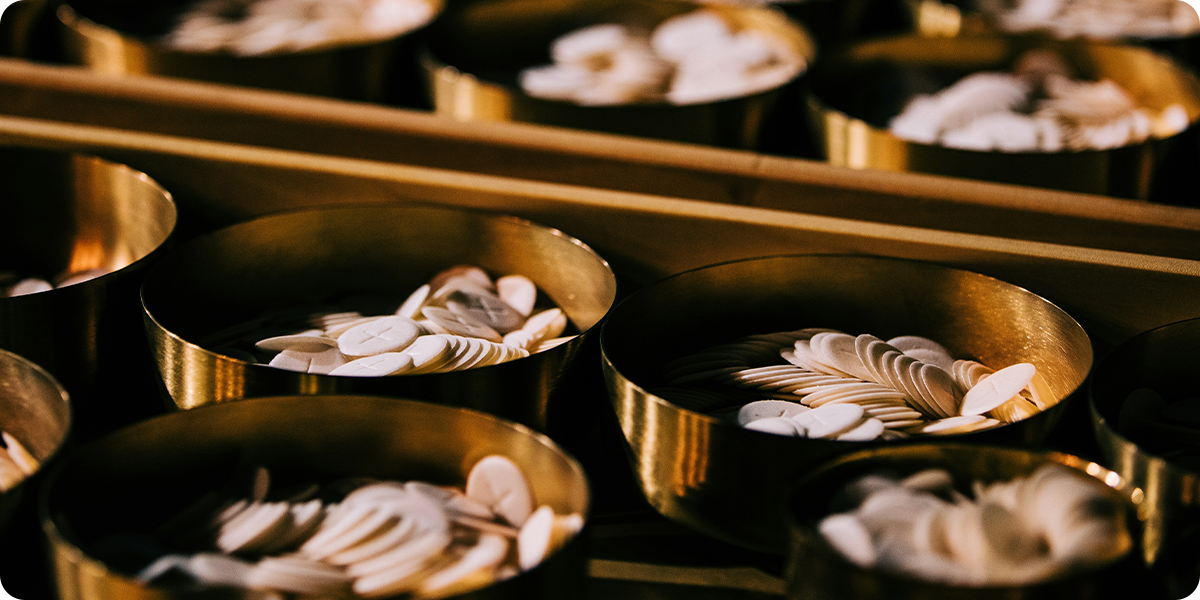

It is almost time for Holy Communion! Having gone through the Eucharistic Prayer and responded together with vigor in the Great Amen, we are now in our final preparations before the moment of Holy Communion. This next section of the Mass is called the Communion Rite. The special parts of this moment in the Mass include:
We’ll be taking a closer look at each part in the coming weeks.

Although we may be familiar with this section of the Mass, perhaps it is helpful to step back and ask, “What exactly are we doing?” Many of us have been receiving Communion for some time, but have we ever stopped to wonder why we do so? As the General Instruction of the Roman Missal says, “Since the celebration of the Eucharist is the Paschal Banquet, it is desirable that in accordance with the Lord’s command his Body and Blood should be received as spiritual food by those of the faithful who are properly disposed. This is the sense of the fraction and the other preparatory rites by which the faithful are led more immediately to Communion” (GIRM, 80).
When we talk about the Eucharist, we usually think about four things: The True Presence of Christ’s Body and Blood; The Sacrifice of the Cross; The Sacrament of Unity among people; and the Paschal or Heavenly Banquet. The True Presence reminds us that Jesus is really there. The Sacrifice reminds us that the Mass is the one perfect Sacrifice of Jesus on the Cross and shows how much Jesus loves us. The True Presence of Jesus and his Sacrifice open the door to restoration, healing, and true unity. These truths also point us toward heaven, where we will experience the fullness and perfection of unity and love. The image of the heavenly banquet calls to mind celebration, eating, and drinking. As Jesus instructed us, we receive his Body and Blood by eating and drinking. That is what the Communion Rite is all about: the point of all the prayers, gestures, and words is that we receive Jesus the Lord in Holy Communion!
Continuing with Charles Belmonte, “The early Christians always likened the Eucharist to the life of the soul. St. Augustine writes: ‘It is an excellent thing that the Christians around Carthage [in North Africa] call baptism itself nothing else but salvation, and the sacrament of Christ’s Body nothing else but life. By apostolic tradition, the churches of Christ hold that without baptism and participation at the Lord’s table it is impossible for any man to attain either the kingdom of God or salvation and life eternal. The Scriptures give testimony to this.’ This is the very same body and blood which, by being immolated, restored our friendship with God. Christ’s sacrifice and the Paschal Meal are intimately linked. Our Mother the Church encourages us to participate in one and in the other, if we are properly disposed, of receiving our Lord’s Body and Blood. These will be our nourishment for the journey to our Father’s home” (Understanding the Mass, pp. 166–67).
For more background on sacrifice and eating, Belmonte looks back at the relationship between sacrifices and banquets: “The ancient sacrificial custom required that part of the victim be given back to the person offering the sacrifice. Thus, he became, symbolically, God’s guest. That which was just a symbol in the pagan rites and a figure in the Jewish offerings is a reality in the Holy Mass. After we have offered to God his Son Jesus Christ in sacrifice, God offers Him to us as spiritual food” (Understanding the Mass, p. 165). So, in the ancient sacrifices, whenever a person would offer a sacrifice to God, he always got “a little something” to take back with him. Generally, this was a portion of the sacrifice. In the case of receiving Jesus in the Mass, we get back the whole Christ: Body, Blood, Soul, and Divinity. What an exchange! There is no better deal in the world!

1. When you divide food or some other kind of created matter into portions, take the opportunity to reflect on the mystery of Christ, wholly present, in every portion of the Eucharistic species.
2. At your next meal, allow your experience of this kind of eating and drinking to help you prepare to encounter Christ through Eucharistic eating and drinking.